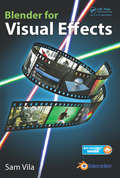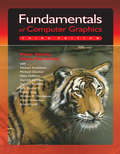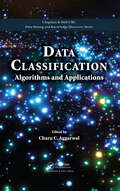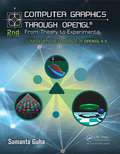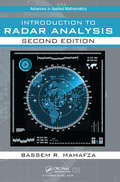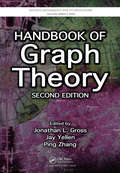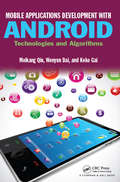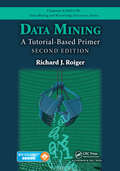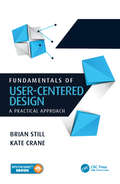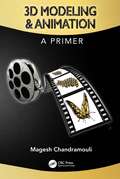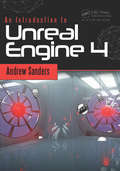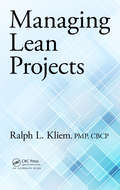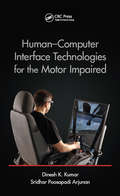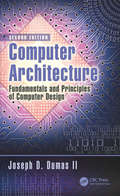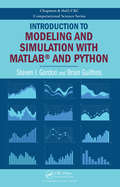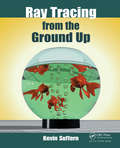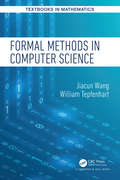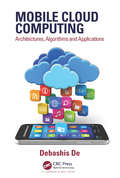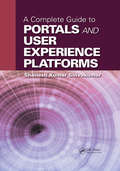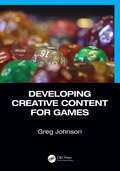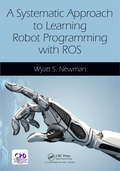- Table View
- List View
Blender for Visual Effects
by Sam VilaBringing concrete examples from industry to light, this book explains how to use Blender to create visual effects for video/film production. It supplies readers with a practical way to learn how to use Blender's tools across a wide range of scenarios in video/film production, including setting up cameras on a stage, lighting, and other production p
Fundamentals of Computer Graphics
by Steve Marschner Peter ShirleyWith contributions by Michael Ashikhmin, Michael Gleicher, Naty Hoffman, Garrett Johnson, Tamara Munzner, Erik Reinhard, Kelvin Sung, William B. Thompson, Peter Willemsen, Brian Wyvill. The third edition of this widely adopted text gives students a comprehensive, fundamental introduction to computer graphics. The authors present the mathematical fo
Data Classification: Algorithms and Applications (Chapman And Hall/crc Data Mining And Knowledge Discovery Ser. #35)
by Charu C. AggarwalComprehensive Coverage of the Entire Area of ClassificationResearch on the problem of classification tends to be fragmented across such areas as pattern recognition, database, data mining, and machine learning. Addressing the work of these different communities in a unified way, Data Classification: Algorithms and Applications explores the underlyi
Computer Graphics Through OpenGL: From Theory to Experiments
by Sumanta GuhaFrom geometric primitives to animation to 3D modeling to lighting, shading, and texturing, Computer Graphics Through OpenGL: From Theory to Experiments, Second Edition presents a comprehensive introduction to computer graphics that uses an active learning style to teach key concepts. Equally emphasizing theory and practice, the book provides an und
Introduction to Radar Analysis (Advances in Applied Mathematics)
by Bassem R. MahafzaIntroduction to Radar Analysis, Second Edition is a major revision of the popular textbook. It is written within the context of communication theory as well as the theory of signals and noise. By emphasizing principles and fundamentals, the textbook serves as a vital source for students and engineers. Part I bridges the gap between communication, signal analysis, and radar. Topics include modulation techniques and associated Continuous Wave (CW) and pulsed radar systems. Part II is devoted to radar signal processing and pulse compression techniques. Part III presents special topics in radar systems including radar detection, radar clutter, target tracking, phased arrays, and Synthetic Aperture Radar (SAR). Many new exercise are included and the author provides comprehensive easy-to-follow mathematical derivations of all key equations and formulas. The author has worked extensively for the U.S. Army, the U.S. Space and Missile Command, and other military agencies. This is not just a textbook for senior level and graduates students, but a valuable tool for practicing radar engineers. Features Authored by a leading industry radar professional. Comprehensive up-to-date coverage of radar systems analysis issues. Easy to follow mathematical derivations of all equations and formulas Numerous graphical plots and table format outputs. One part of the book is dedicated to radar waveforms and radar signal processing.
Handbook of Graph Theory (Discrete Mathematics And Its Applications Ser.)
by Ping Zhang Jonathan L. Gross Jay YellenIn the ten years since the publication of the best-selling first edition, more than 1,000 graph theory papers have been published each year. Reflecting these advances, Handbook of Graph Theory, Second Edition provides comprehensive coverage of the main topics in pure and applied graph theory. This second edition-over 400 pages longer than its prede
Mobile Applications Development with Android: Technologies and Algorithms
by Meikang Qiu Wenyun Dai Keke GaiMobile Applications Development with Android: Technologies and Algorithms presents advanced techniques for mobile app development, and addresses recent developments in mobile technologies and wireless networks. The book covers advanced algorithms, embedded systems, novel mobile app architecture, and mobile cloud computing paradigms. Divided into three sections, the book explores three major dimensions in the current mobile app development domain. The first section describes mobile app design and development skills, including a quick start on using Java to run an Android application on a real phone. It also introduces 2D graphics and UI design, as well as multimedia in Android mobile apps. The second part of the book delves into advanced mobile app optimization, including an overview of mobile embedded systems and architecture. Data storage in Android, mobile optimization by dynamic programming, and mobile optimization by loop scheduling are also covered. The last section of the book looks at emerging technologies, including mobile cloud computing, advanced techniques using Big Data, and mobile Big Data storage. About the Authors Meikang Qiu is an Associate Professor of Computer Science at Pace University, and an adjunct professor at Columbia University. He is an IEEE/ACM Senior Member, as well as Chair of the IEEE STC (Special Technical Community) on Smart Computing. He is an Associate Editor of a dozen of journals including IEEE Transactions on Computers and IEEE Transactions on Cloud Computing. He has published 320+ peer-reviewed journal/conference papers and won 10+ Best Paper Awards. Wenyun Dai is pursuing his PhD at Pace University. His research interests include high performance computing, mobile data privacy, resource management optimization, cloud computing, and mobile networking. His paper about mobile app privacy has been published in IEEE Transactions on Computers. Keke Gai is pursuing his PhD at Pace University. He has published over 60 peer-reviewed journal or conference papers, and has received three IEEE Best Paper Awards. His research interests include cloud computing, cyber security, combinatorial optimization, business process modeling, enterprise architecture, and Internet computing. .
Data Mining: A Tutorial-Based Primer, Second Edition (Chapman & Hall/CRC Data Mining and Knowledge Discovery Series)
by Richard J. Roiger"Dr. Roiger does an excellent job of describing in step by step detail formulae involved in various data mining algorithms, along with illustrations. In addition, his tutorials in Weka software provide excellent grounding for students in comprehending the underpinnings of Machine Learning as applied to Data Mining. The inclusion of?RapidMiner software tutorials and examples in the book is also a definite plus since it is one of the most popular Data Mining software platforms in use today." --Robert Hughes, Golden Gate University, San Francisco, CA, USA Data Mining: A Tutorial-Based Primer, Second Edition provides a comprehensive introduction to data mining with a focus on model building and testing, as well as on interpreting and validating results. The text guides students to understand how data mining can be employed to solve real problems and recognize whether a data mining solution is a feasible alternative for a specific problem. Fundamental data mining strategies, techniques, and evaluation methods are presented and implemented with the help of two well-known software tools. Several new topics have been added to the second edition including an introduction to Big Data and data analytics, ROC curves, Pareto lift charts, methods for handling large-sized, streaming and imbalanced data, support vector machines, and extended coverage of textual data mining. The second edition contains tutorials for attribute selection, dealing with imbalanced data, outlier analysis, time series analysis, mining textual data, and more. The text provides in-depth coverage of RapidMiner Studio and Weka’s Explorer interface. Both software tools are used for stepping students through the tutorials depicting the knowledge discovery process. This allows the reader maximum flexibility for their hands-on data mining experience.
Fundamentals of User-Centered Design: A Practical Approach
by Brian Still Kate CraneThere has been some solid work done in the area of User-Centered Design (UCD) over the last few years. What’s been missing is an in-depth, comprehensive textbook that connects UCD to usability and User Experience (UX) principles and practices. This new textbook discusses a theoretical framework in relation to other design theories. It provides a repeatable, practical process for implementation, offering numerous examples, methods, and case studies for support, and it emphasizes best practices in specific environments, including mobile and web applications, print products, as well as hardware.
3D Modeling & Animation: A Primer
by Magesh Chandramouli"If I were still teaching introductory computer graphics, I would not hesitate to use this textbook as it has just the right amount of coverage of the topic for a semester course and is presented in a highly appealing manner to engage the reader." – Gary Bertoline, PhD, Distinguished Professor of Computer Graphics Technology, Purdue University, USA Graphics-based 3D modeling and animation are relevant not only in the motion picture and video game industry, but also in many other disciplines including creative arts, engineering, architecture, education, medicine, etc. Understanding the basics of 3D modeling, and animation requires understanding some basic concepts in physics and math. While some books assume readers’ prior knowledge of these concepts, 3D Modeling & Animation: A Primer explains these important concepts in a visually engaging manner. This book is not just for university students, but for anyone with an interest in computer graphics modeling and animation. Using a Software-Agnostic approach, this book focuses on modeling and animation concepts spanning across multiple software platforms. Employing a balanced approach that is neither too technical nor too artistic, this book instills the need for creativity and visual composition in animation. KEY FEATURES: • Uses a simple, clear, and concise approach to explain the basics of modeling and animation • Two hundred plus vibrant images to easily understand and appreciate complex concepts • Review questions at chapter ends to help readers better review the content AUTHOR: Magesh Chandramouli is a Professor of Computer Graphics Technology at Purdue University Northwest and is a Distinguished Visiting Faculty of Computer Graphics at Feng Chia University, Taiwan. He is currently serving as the Director of Programs of the Engineering Design Graphics Division of the American Society for Engineering Education. He was a Frederick Andrews Fellow at Purdue University, West Lafayette, where he completed his PhD. He received Master of Science from the University of Calgary, Canada; Master of Engineering from the National University of Singapore; and B.E. from College of Engineering, Guindy, India. He has received National and International awards for his scholarly accomplishments and has delivered invited lectures in reputed universities and research centers around the world.
An Introduction to Unreal Engine 4
by Andrew SandersThis book serves as an introduction to the level design process in Unreal Engine 4. By working with a number of different components within the Unreal Editor, readers will learn to create levels using BSPs, create custom materials, create custom Blueprints complete with events, import objects, create particle effects, create sound effects and combine them to create a complete playable game level. The book is designed to work step by step at the beginning of each chapter, then allow the reader to complete similar tasks on their own to show an understanding of the content. A companion website with project files and additional information is included.
The Re-Evolution of American Street Gangs
by Dale L. June Mohamad Khatibloo Gregorio EstevaneThe problem of gangs and gang subculture is a growing threat to the stability of neighborhoods and entire communities. During the past two decades, gang members have increasingly migrated from large urban centers to suburban areas and other countries. This book addresses the intricacies and diversities of street gangs, drawing on the expertise of h
Managing Lean Projects
by Ralph L. KliemLean is a set of disciplines that can result in tremendous savings and profitability for companies. It can significantly reduce cycle times and increase customer satisfaction. Lean, however, must be applied efficiently and effectively to achieve optimum results. This book discusses project management concepts, tools, and techniques as they apply to
Human-Computer Interface Technologies for the Motor Impaired (Rehabilitation Science In Practice Ser.)
by Dinesh K. Kumar Sridhar Poosapadi ArjunanHuman Computer Interface Technologies for the Motor Impaired examines both the technical and social aspects of human computer interface (HCI). Written by world-class academic experts committed to improving HCI technologies for people with disabilities, this all-inclusive book explores the latest research, and offers insight into the current limitat
Computer Architecture: Fundamentals and Principles of Computer Design, Second Edition
by Joseph D. Dumas IINot only does almost everyone in the civilized world use a personal computer, smartphone, and/or tablet on a daily basis to communicate with others and access information, but virtually every other modern appliance, vehicle, or other device has one or more computers embedded inside it. One cannot purchase a current-model automobile, for example, without several computers on board to do everything from monitoring exhaust emissions, to operating the anti-lock brakes, to telling the transmission when to shift, and so on. Appliances such as clothes washers and dryers, microwave ovens, refrigerators, etc. are almost all digitally controlled. Gaming consoles like Xbox, PlayStation, and Wii are powerful computer systems with enhanced capabilities for user interaction. Computers are everywhere, even when we don’t see them as such, and it is more important than ever for students who will soon enter the workforce to understand how they work. This book is completely updated and revised for a one-semester upper level undergraduate course in Computer Architecture, and suitable for use in an undergraduate CS, EE, or CE curriculum at the junior or senior level. Students should have had a course(s) covering introductory topics in digital logic and computer organization. While this is not a text for a programming course, the reader should be familiar with computer programming concepts in at least one language such as C, C++, or Java. Previous courses in operating systems, assembly language, and/or systems programming would be helpful, but are not essential.
Introduction to Modeling and Simulation with MATLAB® and Python (Chapman & Hall/CRC Computational Science)
by Brian Guilfoos Steven I. GordonIntroduction to Modeling and Simulation with MATLAB and Python is intended for students and professionals in science, social science, and engineering that wish to learn the principles of computer modeling, as well as basic programming skills. The book content focuses on meeting a set of basic modeling and simulation competencies that were developed as part of several National Science Foundation grants. Even though computer science students are much more expert programmers, they are not often given the opportunity to see how those skills are being applied to solve complex science and engineering problems and may also not be aware of the libraries used by scientists to create those models. The book interleaves chapters on modeling concepts and related exercises with programming concepts and exercises. The authors start with an introduction to modeling and its importance to current practices in the sciences and engineering. They introduce each of the programming environments and the syntax used to represent variables and compute mathematical equations and functions. As students gain more programming expertise, the authors return to modeling concepts, providing starting code for a variety of exercises where students add additional code to solve the problem and provide an analysis of the outcomes. In this way, the book builds both modeling and programming expertise with a "just-in-time" approach so that by the end of the book, students can take on relatively simple modeling example on their own. Each chapter is supplemented with references to additional reading, tutorials, and exercises that guide students to additional help and allows them to practice both their programming and analytical modeling skills. In addition, each of the programming related chapters is divided into two parts – one for MATLAB and one for Python. In these chapters, the authors also refer to additional online tutorials that students can use if they are having difficulty with any of the topics. The book culminates with a set of final project exercise suggestions that incorporate both the modeling and programming skills provided in the rest of the volume. Those projects could be undertaken by individuals or small groups of students. The companion website at http://www.intromodeling.com provides updates to instructions when there are substantial changes in software versions, as well as electronic copies of exercises and the related code. The website also offers a space where people can suggest additional projects they are willing to share as well as comments on the existing projects and exercises throughout the book. Solutions and lecture notes will also be available for qualifying instructors.
Ray Tracing from the Ground Up
by Kevin SuffernWith the increase in computing speed and due to the high quality of the optical effects it achieves, ray tracing is becoming a popular choice for interactive and animated rendering. This book takes readers through the whole process of building a modern ray tracer from scratch in C++. All concepts and processes are explained in detail with the aid o
Formal Methods in Computer Science (Textbooks In Mathematics Ser.)
by Jiacun WangThis textbook gives students a comprehensive introduction to formal methods and their application in software and hardware specification and verification. It has three parts: The first part introduces some fundamentals in formal methods, including set theory, functions, finite state machines, and regular expressions. The second part focuses on logi
An Introduction to Applied Electromagnetics and Optics
by Vladimir V. Mitin Dmitry I. SementsovModern technology is rapidly developing and for this reason future engineers need to acquire advanced knowledge in science and technology, including electromagnetic phenomena. This book is a contemporary text of a one-semester course for junior electrical engineering students. It covers a broad spectrum of electromagnetic phenomena such as, surface waves, plasmas, photonic crystals, negative refraction as well as related materials including superconductors. In addition, the text brings together electromagnetism and optics as the majority of texts discuss electromagnetism disconnected from optics. In contrast, in this book both are discussed. Seven labs have been developed to accompany the material of the book.
Mobile Cloud Computing: Architectures, Algorithms and Applications
by Debashis DeMinimize Power Consumption and Enhance User ExperienceEssential for high-speed fifth-generation mobile networks, mobile cloud computing (MCC) integrates the power of cloud data centers with the portability of mobile computing devices. Mobile Cloud Computing: Architectures, Algorithms and Applications covers the latest technological and architectura
Maritime Security: Protection of Marinas, Ports, Small Watercraft, Yachts, and Ships
by Ph.D, Daniel BennyIn a time when threats against the maritime community have never been greater, Maritime Security: Protection of Marinas, Ports, Small Watercraft, Yachts, and Ships provides a single, comprehensive source of necessary information for understanding and preventing or reducing threats to the maritime community.The book defines what comprises the mariti
A Complete Guide to Portals and User Experience Platforms
by Shailesh Kumar ShivakumarBuild a Next-Generation Enterprise Digital Platform with Portals and UXPA Complete Guide to Portals and User Experience Platforms provides in-depth coverage of portal technologies and user experience platforms (UXPs), which form the key pillars of a modern digital platform. Drawing on his experience in various roles in numerous portal engagements,
Police Corruption and Police Reforms in Developing Societies
by Kempe Ronald Hope Sr.Much of the literature on police corruption and police reforms is dominated by case studies of societies classified as developed. However, under the influence of globalization, developing societies have become a focal point of scholarly interest and examination. Police Corruption and Police Reforms in Developing Societies provides critical analyses
Developing Creative Content for Games
by Greg JohnsonThis book provides readers with a solid understanding of game development, design, narrative, charaterization, plot, back story and world creation elements that are crucial for game writers and designers as they create a detailed world setting, adventure, characters, narrative and plot suitable for possible publication. Game design and development issues such as writing for games, emergent complexity, risk reward systems, competitive and cooperative game play will be investigated, analyzed and critiqued. Examples will be used to highlight and explain the various concepts involved and how the game development process works. <P><P> Key Features <li>Provides the critical skills any good game designer should have, such as narrative, characterization, progression, challenges, world building, plot, and rewards <li>Using a hands-on, learn-by-doing approach, this book teaches prospective game designers how to excel in creating their own worlds and adventures without having to learn any programming or technical computer skills <li>Includes clear and concise chapter objectives, chapter overviews, examples, case studies, key terms and multiple in-depth analyses <li>Multiple case studies are provided and thoroughly analyzed so that readers will be familiar with the concepts and methodologies involved in each task <li>Over the course of the book, readers will develop a professional level asset for inclusion in a portfolio of work suitable for submitting to job applications
A Systematic Approach to Learning Robot Programming with ROS
by Wyatt Newman<p>A Systematic Approach to Learning Robot Programming with ROS provides a comprehensive, introduction to the essential components of ROS through detailed explanations of simple code examples along with the corresponding theory of operation. The book explores the organization of ROS, how to understand ROS packages, how to use ROS tools, how to incorporate existing ROS packages into new applications, and how to develop new packages for robotics and automation. It also facilitates continuing education by preparing the reader to better understand the existing on-line documentation. <p>The book is organized into six parts. It begins with an introduction to ROS foundations, including writing ROS nodes and ROS tools. Messages, Classes, and Servers are also covered. The second part of the book features simulation and visualization with ROS, including coordinate transforms. <p>The next part of the book discusses perceptual processing in ROS. It includes coverage of using cameras in ROS, depth imaging and point clouds, and point cloud processing. Mobile robot control and navigation in ROS is featured in the fourth part of the book <p>The fifth section of the book contains coverage of robot arms in ROS. This section explores robot arm kinematics, arm motion planning, arm control with the Baxter Simulator, and an object-grabber package. The last part of the book focuses on system integration and higher-level control, including perception-based and mobile manipulation. <p>This accessible text includes examples throughout and C++ code examples are also provided at https://github.com/wsnewman/learning_ros</p>
